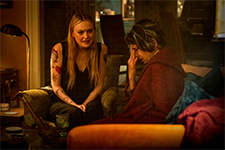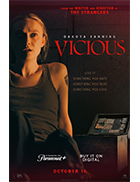Vicious
|  I have now seen three of the five horror films Bryan Bertino has written and directed, and I feel confident in reporting that he is an excellent director who needs better story material. His feature debut, The Strangers (2008), was a first-rate genre exercise that proved Bertino to be a master of camera placement and movement, evoking brutal tension and suspense in a manner similar to what John Carpenter achieved in Halloween (1978). His bravura craftsmanship compensated for the lack of story or characters. Similarly, his fourth feature, The Dark and the Wicked (2020), focused primarily on style and atmosphere, although he did take some stabs at exploring theological issues (his characters remained largely flat types). There wasn’t much there, but it was more. And how we have Vicious, his first film in five years, and the title is definitely apropos. Bertino is nothing if not a brutal, relentless, vicious purveyor of horror at its most base and visceral, and his films benefit from his innate sense in how to rachet tension to nearly unbearable levels. He favors torturous scenarios in which flawed, hurting characters with damaged backgrounds are put through the wringer, and that is exactly what we get here. But, even more so than in his previous films, the lack of a clear connection between the protagonist in Vicious and the horrific situation in which she finds herself makes everything that happens feel overly cruel and, possibly worse, entirely arbitrary. Vicious begins in top form, with little more than a slowly rotating camera and an escalating ambient score to set the stage for the horrors to come. And then we get the narrative set-up, which has great promise: We are introduced to Polly (Dakota Fanning), a young woman in her early 30s who, as we quickly learn, has not had much success in life, bouncing from job to job and finding it impossible to maintain lasting relationships. She lives in a cavernous Victorian duplex in a large city that feels strangely deserted. She rents the duplex from her older and much more successful sister (otherwise there would be no justification for someone like her having such enormous digs). She is preparing for a job interview late at night when the doorbell rings and she finds a small, seemingly confused woman (Kathryn Hunter) on her snowy doorstep looking for the home’s previous owner. Polly, trying to be nice, invites her in, which turns out to be a horrible mistake. The already awkward encounter becomes more worse when the woman begins telling Polly that she will die that night, and then leaves in her possession a wooden box inside of which is an hourglass. As she soon learns, the box is the centerpiece of some kind of supernatural entity that takes over her world, forcing her to put three things in it: something she hates, something she needs, and something she loves. For the rest of the film Polly is tormented by this omniscient, omnipresent entity, which appears to have at its disposal every tool in the horror-movie playbook: It can appear to her as grotesque versions of her loved ones, stalk her wherever she goes, force others to kill themselves, kill others, imitate friends and family, and control every electronic device around, from cell phones to television sets. Whatever it is—and, this being a Bryan Bertino film, don’t expect any explanations—it is everywhere and it is determined to force Polly to do what it wants. For Dakota Fanning, this provides an excellent opportunity to stretch her acting chops to the max, as she gets to play confused, angry, sad, terrified, distraught, and distressed. She screams, she recoils, she throws things, chops off appendages, weeps uncontrollably. It is all, ultimately, quite exhausting, especially when you realize at some point that there really is no point. As I have argued many times, ambiguity can be a crucial aspect of good horror, and too many horror films spend too much time trying to explain everything. Some degree of mystery needs to survive to keep monsters monstrous. Bertino, however, tends to abuse ambiguity by using it as an excuse to do whatever he wants. If we never know what the supernatural entity is, what it wants from Polly, and why it is doing anything it is doing, then it can literally do anything. This allows Bertino to exercise what he does best—using camera movement and lighting and shallow focus and careful compositions to put the screws to our nervous system. But, at some point you might start to feel as resentful as Polly does in being used and abused with no clear sense of purpose. “What do you want!?!?” Polly shrieks on more than a few occasions, and you might feel like shrieking the same thing yourself. Copyright © 2025 James Kendrick Thoughts? E-mail James Kendrick All images copyright © Paramount Pictures |
Overall Rating: 
 (2)
(2)


